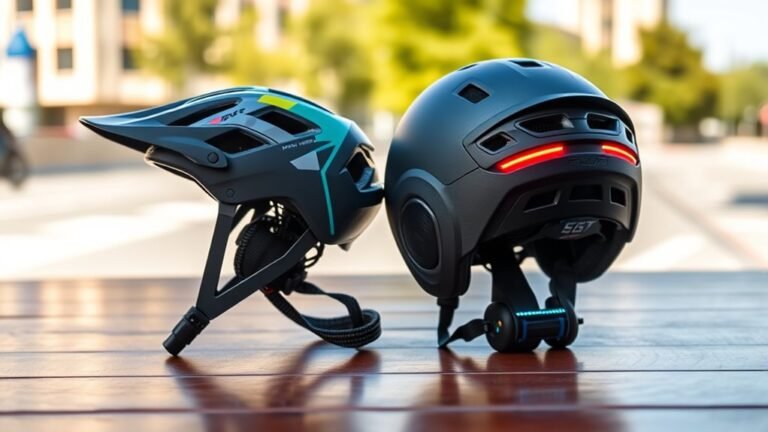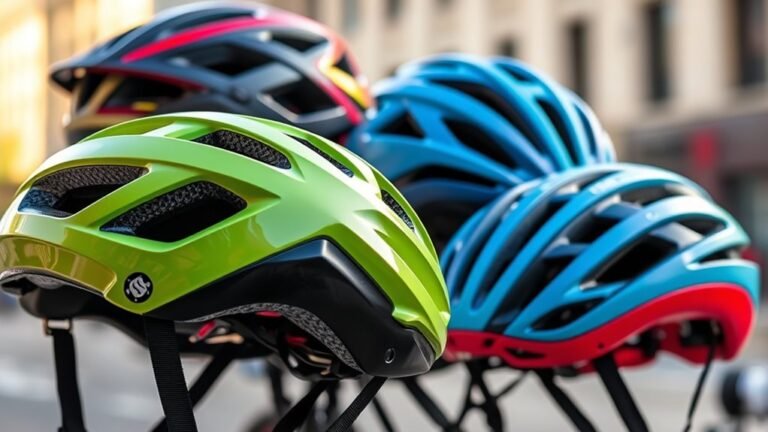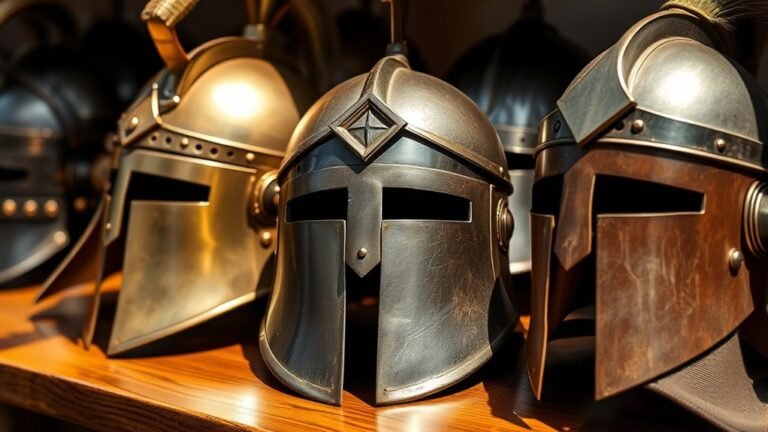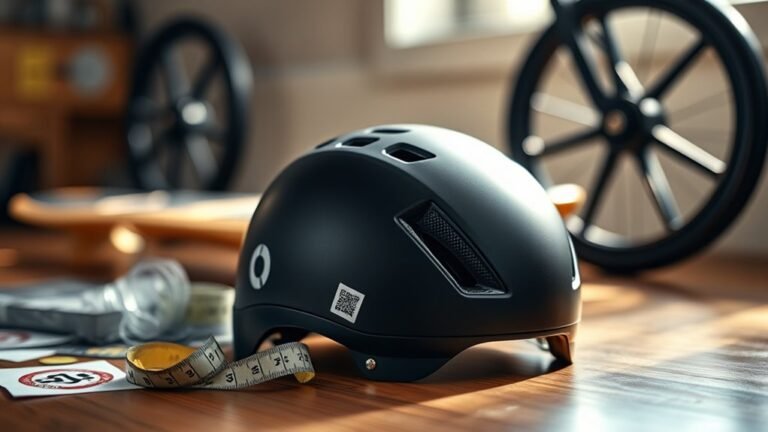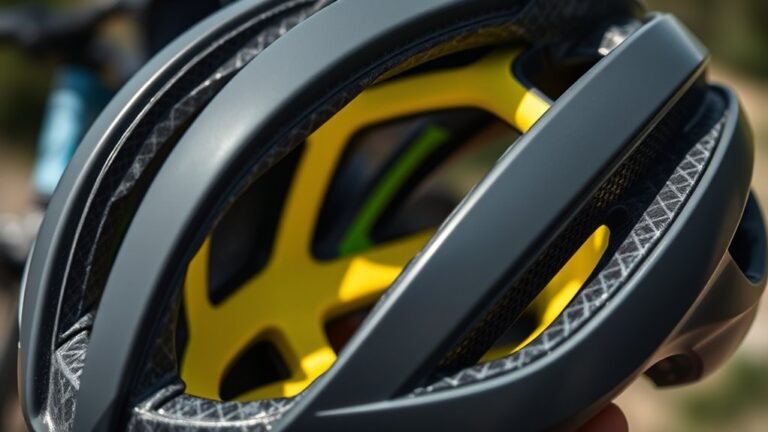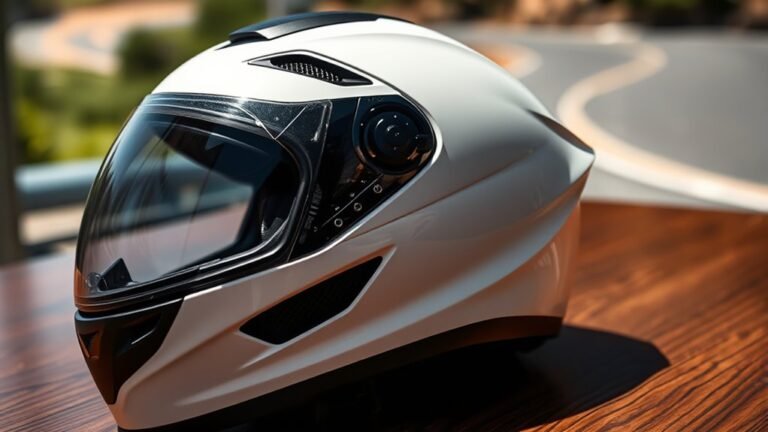Best Bicycle Helmets for Kids’ Safety
When choosing the best bicycle helmet for your child’s safety, make sure it meets safety standards like CPSC or ASTM. Look for lightweight materials for comfort and adjustable straps for a secure fit. Helmets like the Bell Sidetrack or Giro Scamp offer durability and style, encouraging kids to wear them. Proper fit is essential; it should sit level just above the eyebrows. Keeping maintenance in mind will guarantee longevity. There’s more to discover about selecting the right helmet.
Importance of Bicycle Helmets for Kids
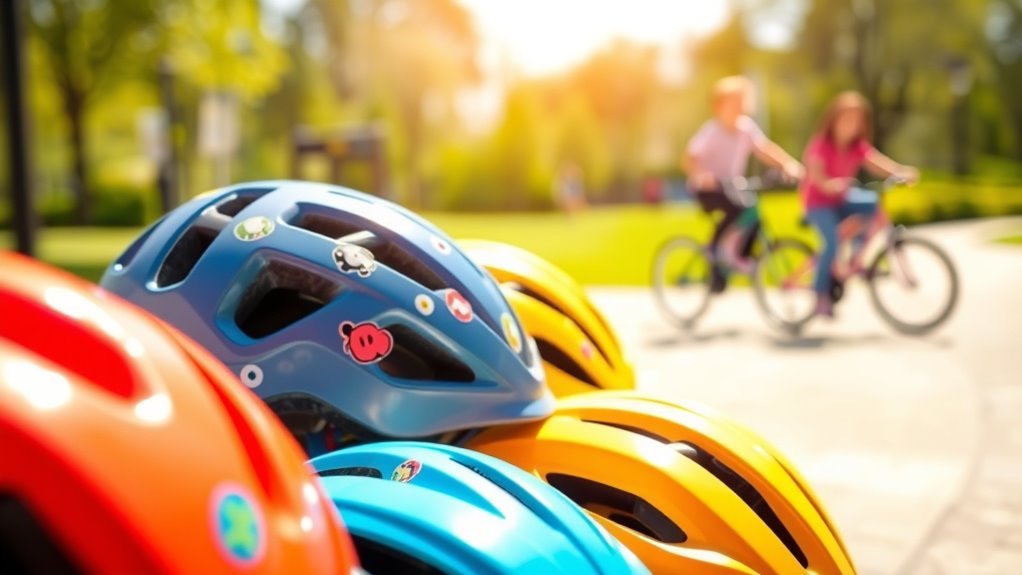
When it comes to ensuring your child’s safety while riding a bicycle, wearing a helmet is essential. Helmets considerably reduce the risk of head injuries in the event of an accident, promoting overall child safety. Not only do they protect against impacts, but they also foster riding awareness. When your child sees that helmets are important, they’ll understand the significance of being cautious while cycling. Encouraging helmet use helps instill responsible riding habits, ensuring they’re more aware of their surroundings and potential hazards. As you emphasize the necessity of a helmet, you’re empowering your child to enjoy the freedom of biking while prioritizing their well-being. Ultimately, a helmet is a small yet essential investment in your child’s safety and confidence on the road.
Key Features to Look for in Kids’ Helmets
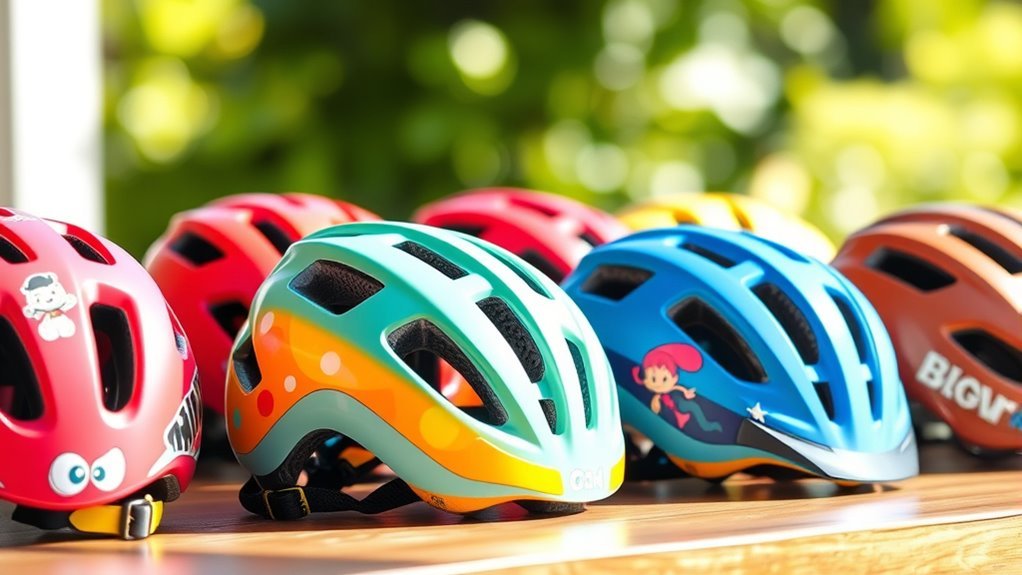
Choosing the right helmet for your child is vital for their safety and comfort while cycling. First, verify it meets recognized safety standards, such as those set by the CPSC or ASTM. These standards guarantee the helmet can withstand impacts and protect your child effectively. Next, look for lightweight materials; a helmet that’s too heavy can cause discomfort and distract from the joy of riding. Additionally, check for proper fit—an adjustable chin strap and padding can enhance security and comfort. Ventilation is also important; a well-ventilated helmet will keep your child cool during rides. Finally, consider the design and color—your child’s enthusiasm for wearing the helmet can greatly influence their safety while enjoying their freedom on two wheels.
Top Picks for Best Kids’ Bicycle Helmets
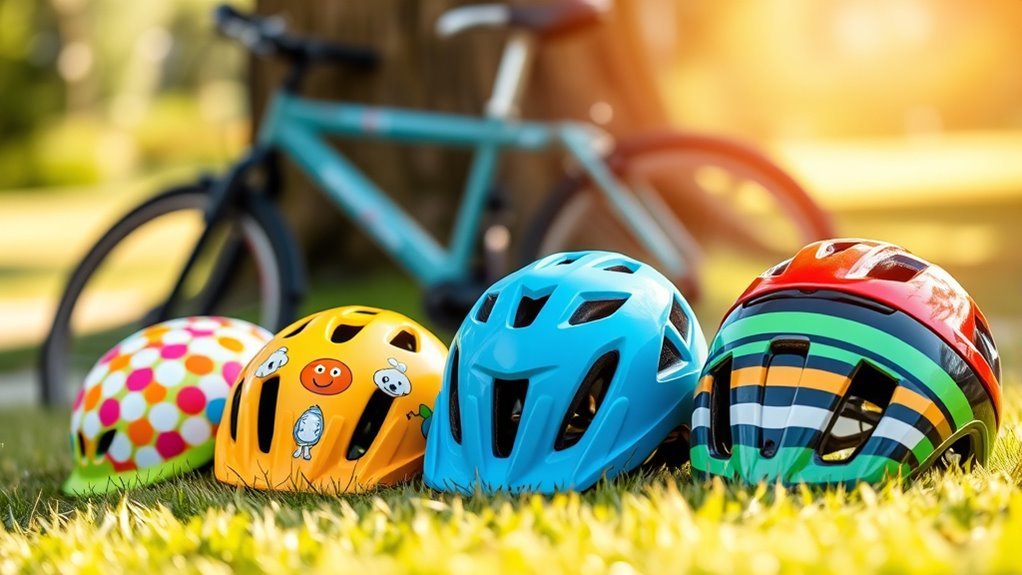
Finding the best kids’ bicycle helmet can feel overwhelming with so many options available. You want a helmet that meets safety standards while being comfortable and stylish. One top pick is the Bell Sidetrack, crafted from durable polycarbonate materials, ensuring both strength and lightweight comfort. Another excellent choice is the Giro Scamp, which features a secure fit system and moisture-wicking padding, perfect for those long rides. For budget-conscious parents, the Schwinn Toddler Helmet offers reliable protection without breaking the bank, utilizing quality materials that comply with safety standards. Remember, a great helmet combines safety, style, and comfort, allowing your child to enjoy the freedom of cycling while staying protected on the road.
How to Ensure a Proper Fit
To guarantee a proper fit for your child’s bicycle helmet, start by measuring their head circumference to find the right size. Once you have the correct helmet, adjust the straps so they sit snugly without pinching. Finally, check that the helmet is positioned level on their head, just above the eyebrows for ideal protection.
Measure Head Circumference
Accurate measurement of your child’s head circumference is essential for ensuring a proper fit of their bicycle helmet. To get the correct head size, use a flexible measuring tape. Wrap it around the largest part of your child’s head, typically just above the eyebrows and ears. Make sure it’s snug but not too tight. Record the measurement in centimeters or inches, and refer to the helmet manufacturer’s sizing chart to choose the right size. If your child falls between sizes, opt for the larger size for comfort and adjustability. Remember, a well-fitted helmet can make all the difference in safety and enjoyment while riding, allowing your child to explore with confidence.
Adjust Straps Correctly
While guaranteeing your child’s bicycle helmet fits properly, adjusting the straps is essential for maximizing safety and comfort. Follow these adjustment techniques to achieve the best strap positioning:
| Step | Action | Purpose |
|---|---|---|
| 1 | Place helmet on the head | Ensure it sits level |
| 2 | Adjust chin strap | Should be snug but allow for two fingers |
| 3 | Slide side straps through the sliders | Keep straps close to the ears |
| 4 | Check the rear adjustment buckle | Ensure it’s secure and comfortable |
| 5 | Have your child shake their head | Verify helmet stays in place |
Check Helmet Position
Ensuring that your child’s helmet is positioned correctly is essential for their safety while riding. Start by checking the helmet alignment; it should sit level on their head, not tilted back or forward. The front edge should rest about an inch above their eyebrows, providing a clear view without obstructing vision. Next, verify the snugness; the helmet should feel secure but not overly tight, ensuring helmet comfort. You can test this by having your child shake their head; if the helmet shifts considerably, it needs adjusting. Don’t forget to check the straps; they should form a V-shape just below the ears. A properly fitted helmet boosts safety and allows your child to enjoy their ride with confidence and freedom.
Fun Designs That Kids Will Love
When choosing a helmet for your child, consider designs featuring their favorite cartoon characters or bright, eye-catching colors. These fun aesthetics not only make the helmet more appealing but can also encourage your child to wear it consistently. A helmet that they love will enhance their safety while riding.
Favorite Cartoon Characters
Brightly colored helmets featuring favorite cartoon characters can turn safety into a fun experience for kids. When you choose a helmet adorned with engaging cartoon themes, it can spark your child’s imagination and encourage them to wear it every time they ride. Look for character patterns that showcase beloved figures from popular shows or movies, making the helmet feel special. These designs not only make safety more appealing but also help your child express their personality. Additionally, helmets with cartoon characters often come in various sizes and styles, ensuring a comfortable fit. By combining safety with fun designs, you’ll instill in your child the importance of wearing a helmet while allowing them to enjoy their favorite characters on their rides.
Bright, Eye-Catching Colors
Choosing a helmet in bright, eye-catching colors can make all the difference in encouraging kids to wear their safety gear. Vibrant color options not only appeal to children’s sense of fun but also greatly enhance visibility. When your child rides in a brightly colored helmet, they’re more noticeable to motorists and other cyclists, providing an added layer of safety. Helmets featuring fun designs and colors can transform safety into something exciting, making kids more willing to put them on. Look for helmets that combine these vibrant aesthetics with proper safety certifications to guarantee effective protection. Ultimately, a helmet that kids love to wear can lead to safer riding experiences and peace of mind for parents.
Maintenance and Care for Bicycle Helmets
Although bicycle helmets are designed to withstand impact, regular maintenance and care are essential to secure their longevity and effectiveness. To extend your helmet’s lifespan, adopt proper cleaning techniques. Start by wiping the exterior with a damp cloth and mild soap to remove dirt and grime. Avoid harsh chemicals, as they can damage the helmet’s materials. Check the straps and buckle for wear; replace them if they show signs of fraying or damage. Store the helmet in a cool, dry place, away from direct sunlight, to prevent warping. After each ride, inspect the helmet for any cracks or dents, which could compromise safety. By following these simple steps, you’ll make certain your child’s helmet remains a reliable safety accessory.
Transitioning to Advanced Helmets as They Grow
As your child grows and develops their cycling skills, it’s important to shift them to more advanced helmets that offer enhanced protection and features. Today’s helmet technology advancements have led to designs that are lighter yet more durable, providing ideal safety without sacrificing comfort. Look for helmets that meet growing safety standards, ensuring they deliver the highest level of protection.
As your child moves to more challenging rides, consider features like adjustable fit systems and improved ventilation. These elements not only enhance safety but also encourage them to ride more confidently. By investing in an advanced helmet, you’re not just prioritizing their safety; you’re also empowering them to embrace their freedom on two wheels.
Frequently Asked Questions
At What Age Should Kids Start Wearing Bicycle Helmets?
Kids should start wearing bicycle helmets as soon as they begin riding, typically around ages 1 to 2. Helmet safety is vital at this stage, as even small falls can lead to serious injuries. Age guidelines suggest that all children under 18 should wear a helmet when cycling. Encourage your child to embrace this safety habit early on, allowing them to enjoy their freedom while keeping their head protected. Always prioritize safety first!
Can Kids Decorate Their Helmets Without Compromising Safety?
Yes, kids can decorate their helmets without compromising safety! Helmet customization is a fun way for them to express their personalities. When adding safety stickers, make sure they’re non-adhesive and specifically designed for helmets to avoid disturbing the helmet’s protective features. Avoid covering vents or critical areas. With the right approach, kids can enjoy their unique designs while staying safe on their rides, allowing them the freedom to showcase their creativity!
How Often Should Helmets Be Replaced?
Just like a knight must replace his worn armor, you should replace a helmet every 3 to 5 years, or sooner if it’s been involved in a crash. These helmets have a lifespan limited by wear and tear, so adhering to replacement guidelines is essential for safety. Check for cracks or damage regularly, and remember, your freedom on the bike is best enjoyed when your helmet’s ready to protect you.
Are There Weight Limits for Kids’ Bicycle Helmets?
There aren’t strict weight limits for kids’ bicycle helmets, but it’s essential to choose one that meets safety standards. A properly fitting helmet should feel lightweight on their head, without compromising protection. Look for helmets designed specifically for children, as these often balance weight and safety features effectively. Always check the manufacturer’s guidelines to guarantee you’re selecting an appropriate model that enhances their freedom to ride while keeping them safe.
What Are the Signs a Helmet Is Damaged?
When you inspect a helmet, look for cracks, dents, or any warping that disrupts its shape. If the foam feels soft or crumbly, it’s time to replace it. Check the straps, too; if they’re frayed or the buckle’s broken, that helmet’s no longer reliable. Remember, a damaged helmet can’t meet safety standards, and your freedom on the road deserves the best protection. Stay vigilant for any signs of wear.

